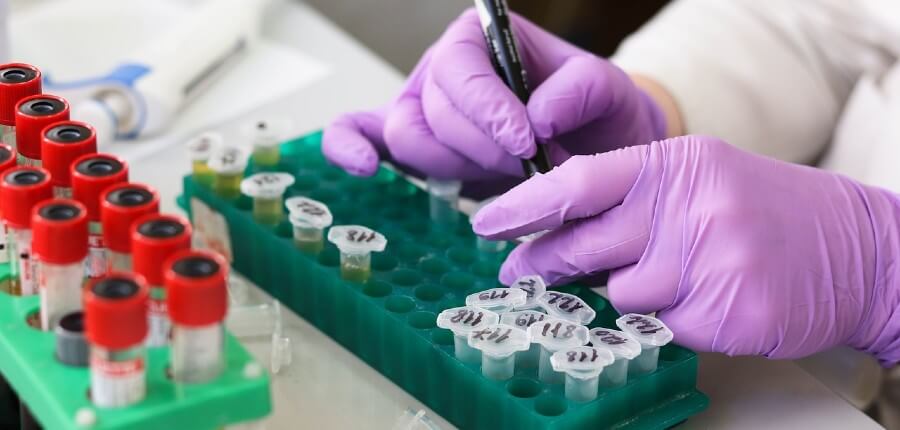What Happened To Prove Animal Testing Is Bad

Bad Scientific discipline: PETA Explains Tests That Torment Animals
If you're an creature advocate, you're probably used to having friends and family come to you for knowledge and guidance on near any animal-related issue. While you might be fluent in the cruelty of the fur trade or an expert on all the latest tasty vegan products (someone has to exam that newest flavor of vegan ice cream, right?), when the conversation turns to testing on animals, many of united states feel a chip natural language-tied.
Don't worry—nosotros've got you covered! Hither's a simple breakup of the most common tests that are performed on animals forth with information concerning why the results of those tests are misleading and the superior methods that tin replace them.
Vaccine Testing
Before new vaccines end up in your md'due south function or pharmacy, they're typically required to go through years of tests on animals. Regulatory agencies claim that this is to decide whether vaccines are safe and constructive, but testing on other species is a shot in the nighttime, at all-time. In fact, 95% of drugs that pass creature tests fail in human trials because they're ineffective or unsafe, according to the National Institutes of Wellness (NIH). For instance, more than 100 HIV/AIDS vaccines have been successful in experiments on animals, only not i of them has fabricated a substantial difference for humans.
Nonetheless, there are signs of hope: As the race to find a COVID-19 vaccine has shown, the typical lengthy process of testing vaccines on animals simply isn't necessary. Bypassing barbarous and misleading tests on animals and instead relying on faster and more human-relevant not-animal tests earlier going to human trials can shave years off the vaccine-development process—and save countless lives.
Systemic Toxicity Testing
Systemic toxicity testing on animals is an outdated and crude attempt to determine how dangerous exposure to a chemical or substance is. One notorious version of this test has been effectually since World State of war I: the lethal dose fifty percent (LD50) test. Information technology involves strength-feeding groups of animals increasing amounts of a exam substance or applying it to their peel until half of them dice. In that location are many sophisticated means to test toxicity without harming animals, including jail cell-based tests and computer models.
Carcinogenicity Testing
Rats and mice are often used in tests that effort to appraise the carcinogenicity (cancer-causing potential) of various substances. For up to ii years, hundreds of animals are exposed to a test substance by inhalation, ingestion, injection, or smearing it on their skin. Then, they are killed so that their bodies can exist examined for signs of cancer. Tests on rodents, though, don't accurately predict whether a substance will crusade cancer in humans. Modern non-animal tests, such as in vitro methods, use prison cell, tissue, or organ models exterior of a living organism to mensurate the tumor-initiating activity and tumor-promoting action of a substance and are much more than reliable—non to mention humane.
Skin and Heart Irritation/Corrosion Testing
These rough tests are just equally painful every bit their names imply. They involve applying substances to rabbits' eyes or smearing them onto their shaved peel and recording the damage—which tin include inflamed skin, ulcers, bleeding, bloody scabs, swollen eyelids, irritated and cloudy eyes, and even blindness. These tests are not reliable predictors of human peel and eye reactions and can exist replaced with advanced and authentic methods, such as jail cell tests or 3-D pare or eye tissue models.
Pare-Sensitization Testing
To examination for allergic responses (also called "sensitization"), a substance is injected nether guinea pigs' peel or practical to the ears of mice, who are subsequently killed so that their lymph nodes can be removed and their immune response measured. Instead of using living, feeling beings, this type of testing can be performed in exam tubes or by using cells that react to substances the same fashion that human skin does. In fact, extensive studies take shown that various non-animal methods predict the human response as well as or amend than the animal tests.
Marvel-Driven Testing
Many tests autumn into the "curiosity-driven" category, which is also known as "bones research." This means that they are washed without a articulate goal in mind. Instead, animals used in these tests suffer and die in an experimenter's quest to publish papers and seek more funding.
For case, experimenter Elisabeth Murray conducts "emotional responsiveness" tests on dozens of monkeys in her laboratory at the National Institute of Mental Wellness, which is office of NIH in Bethesda, Maryland. She saws open their skulls and injects toxins to destroy their encephalon cells or suctions out parts of their brain. She forces them to alive in social isolation, surgically implants devices into their skulls, deliberately provokes their worst fears, simply to encounter how they will react, and then kills them. Murray has spent more than $36 million in public funds in the by 13 years alone to torment monkeys, yet not 1 treatment or cure for humans has come out of her laboratory in xxx years.
Ideally, basic research produces foundational noesis for a amend agreement of the causes of affliction in humans. When other animals are left out of the equation, at that place is a far greater likelihood that this will happen. Man-relevant, curiosity-driven research may include the utilise of human being tissues and cells in in vitro studies, man information, not-invasive imaging using human volunteers, and observational studies.
A Test of Ingenuity
The good news is that scientists are increasingly moving away from their reliance on animals for these tests. With your support, PETA is leading the way in promoting and funding the development and utilise of cutting-edge non-animal testing methods. These methods are saving animals from painful, deadly experiments—and they're saving human lives by producing fast, accurate results.
Source: https://prime.peta.org/news/bad-science-peta-explains-tests-on-animals/
Posted by: haassobsell.blogspot.com

0 Response to "What Happened To Prove Animal Testing Is Bad"
Post a Comment